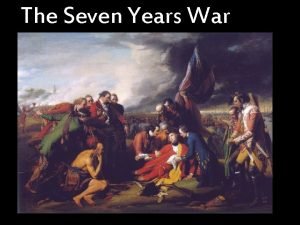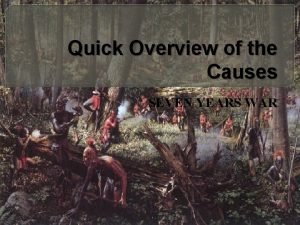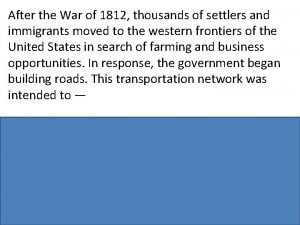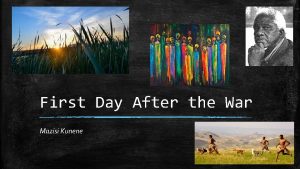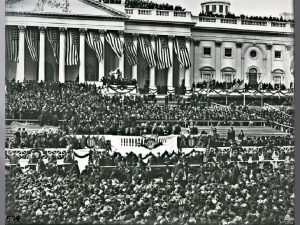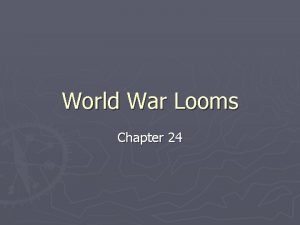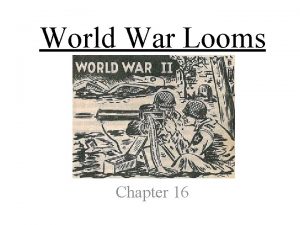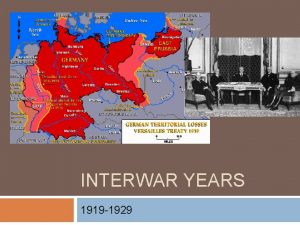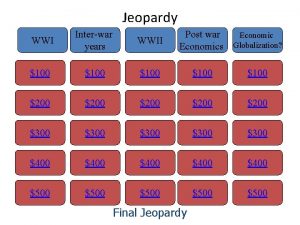Chapter 7 The Interwar Years After the war




























































































































- Slides: 124

Chapter 7: The Interwar Years After the war ended the returning soldiers and the growing population needed jobs

Many who could not find jobs moved away to Canada or the United States

The fishery was still the main employer but after the war demand for salt fish decreased and the prices dropped

Newfoundland had depended on salt fish production for most of its exports throughout its history

When there was lots of fish and prices were good the economy was good

In years when fish was scarce and/or prices were low the economy suffered.

Depending on one product was therefore risky and government and business people felt that this situation must change

They decided they needed economic diversification – economic development that depends on a variety of industries rather than one industry

Government tried to start industries in production of explosives, fertilizer and peat processing

Some industries failed completely while others had different levels of success

Mines were developed in St. Lawrence and Buchan’s and the forestry industry developed on the west coast and in Labrador

Government concentrated on landbased industries – industries related to agriculture, forestry and mining

This caused people to move away from the shoreline and to settle inland

Newfoundland Labrador experienced a period of expansion as new towns grew up in the interior of the country

This caused a big change in the lifestyles of the people that worked in these industries

Mining Most of the mining today is in Labrador

During the 1800’s most of the mining in Newfoundland was copper and iron ore

Look at the timeline on page 151

Buchan’s Mine The mine at Buchan’s was discovered by Mathew Mitchell, a prospector of Mi’kmaw and Innu descent

The ore at Buchans consisted of zinc, lead, copper, gold and silver

Although discovered in 1905 the mine did not begin production until 1927 because the technology to process the minerals had not been developed

The mining company built a company town in the wilderness away from the ocean

Within 3 years it had a mine and processing mill, a school, a church, a hospital, a hydroelectric plant as well as bunkhouses and cottages as accommodations for the miners

It would have been one of the most modern towns in the dominion at the time

St. Lawrence A fluorspar mine was developed in St. Lawrence in 1933.

St. Lawrence was a fishing town that had its fishing grounds destroyed by the tidal wave in 1929

Many people were living in poverty as the Great Depression had begun in 1929 as well

The mining company took advantage of the people’s desperation and forced them to mine 2000 tons of fluorspar for free before they would begin to be paid

After that they were paid only $0. 15 per hour as compared to $0. 22 paid in Buchans and in Bell Island

The original mines were open pit but eventually shafts were sunk far underground

The working conditions were very poor with the air filled with dust and smoke as the shafts were not ventilated

The shafts often flooded and the miners did not have proper safety gear

Working in the mine did improve their standard of living but the poor conditions caused many health problems later in their lives

• Read “Working Underground” on page 154 • Study “Working at the Mines on page 155 • How do you think working conditions would differ today?

Forestry was the first industry that moved people into the interior of the island in a big way

Between 1890 and 1900 200 sawmills were developed. By the 1920’s many of them were closed because of the over cutting of suitable trees

There was a strong demand for newsprint worldwide so a pulp and paper mill was opened in Grand Falls in 1909 and another in Corner Brook in 1925

Many families gave up the unpredictable life of fishing and decided to take jobs as loggers or production workers for a regular paycheck

Some Mi’kmaq worked as loggers as fur prices were very low during the 1920’s and 1930’s

Glenwood and Badger became logging towns and Bishop Falls and Deer Lake had hydroelectric plants

Bishop Falls also had a pulp plant that operated from 1911 to 1954. Wood pulp was pumped to Grand Falls through a pipe and a flume.

Since Grand Falls was not a port the town of Botwood became the shipping center for the Grand Falls mill

By the 1930’s the export value of pulp and paper was bigger than the value of fish exports

People in Grand Falls and Corner Brook lived comfortably through the Great Depression and the following years with steady jobs and income and a modern town in which to live.

This was far different than the fishermen’s lives during the Depression

Labrador In Labrador during the early 1900’s fur prices were strong and forestry provided some jobs.

The Innu suffered because the bigger population was destroying much of the game that they depended on for food

In 1902 Canada protested when Newfoundland gave a forestry company permission to cut wood in the interior of Labrador

Canada said Newfoundland owned only a thin strip of land along the coast

In 1907 the dispute was put before the highest court in England

In 1927 the court gave Newfoundland the coast line and all the land that had rivers flowing to the Atlantic Ocean

The land grant was actually twice as big as the island portion of the province

When Newfoundland gained control of Labrador it led to some development in Labrador, mostly in forestry.

Read “Logging in Labrador” on page 160 Why do you think people put up with such terrible living conditions?

Family Life and Women’s Roles When men were hired in industrial jobs lifestyles changed dramatically

Steady wages gave the whole family a better standard of living

Men might be away at lumber camps for months or working shift work which meant women must take a bigger role in raising the family

Subsistence farming and living under the truck system were no longer factors in their lives

Women did not have to help with the making of fish which took so much time for fishing families

Some women left small towns and went to St. John’s, Canada or the U. S. to become domestic servants

Disasters and Crises 1929 Tidal Wave On November 18 th, 1929 an earthquake on the Grand Banks caused a tsunami which hit 40 communities on the South Coast

Waves as high as 15 meters destroyed buildings and boats and killed 27 people

People from all over Newfoundland other parts of the British Empire donated money to help those affected

The next few years were bad ones in the fishery and many people believed that it was because of the damage done to the ocean floor

Great Depression The Great Depression, a major downturn in the economy, began in 1929 and affected the economy all over the world

Newfoundland was hit very hard because of a poor fishery that included low prices.

Between 1929 and 1932 the value of the fishery fell from 16 million dollars to 6 million dollars

The money government was receiving also declined and the public debt grew to 100 million dollars from money borrowed to finance the railway and the war effort

Government could no longer borrow money to help people and many people had to turn to social assistance (known as “the dole”) to survive.

Being on the dole was considered a disgrace and the amount of money they received was inadequate.

A family of 4 would get $7. 70 a month whereas a family of 10 would get $17. 00 a month

In some ways rural Newfoundland was better off than many places because people could hunt and fish for food as well as grow their own vegetables

Look at the chart on page 164 How does this compare to your diet?

Read “Coping with the Great Depression” on page 165 What did he mean when he said “we managed nicely”?

Read Sir Richard Squires on page 166 and complete the following Write his name, place of birth and date of birth and death Choose 4 -6 events related to Sir Richard Squires’s work and list the events in a chronological timeline.

St. John’s Riot of 1932 People became desperate during the Great Depression. Many people were hungry and did not have enough money to survive

There was a riot in Carbonear where a group of men had a meeting to ask for a raise in the amount of dole

People sometimes broke into merchant’s stores out of desperation to get food for their families

In 1932 the government was desperate for money and decided to raise duties on imported goods. Since most of Newfoundland’s basic food items were imported this drove up the cost of living

They also laid off government workers to save money which added to the number of people unemployed

Prime Minister Richard Squires was accused of paying himself $5000 a year from money meant for war veterans and widows

The Colonial Building was looted and much of the furniture was destroyed or burnt in a bonfire outside the building

Richard Squires was hidden inside and later escaped through a side door

Read “Mob Violence in St. John’s” on page 168 Do you think this news story is biased? What does this say about newspapers at the time?

Commission of Government After the St. John’s Riot Richard Squires dissolved his government and called an election for June 11, 1932

The United Newfoundland Party led by Frederick Alderdice won 25 of the 27 seats

The new government was heavily in debt and was spending two-thirds of all its revenue on paying the interest on the debt

The British government gave Newfoundland a loan to pay that year’s interest on condition they would allow a royal commission to study the public affairs of Newfoundland

The Amulree report concluded that the political leaders in Newfoundland were incompetent and they had caused Newfoundland’s financial problems

They suggested that Newfoundland suspend responsible government and be run by a group of commissioners

This idea was voted on by the legislature on December 2 nd, 1933 and Newfoundland chose to give up its right to responsible government

The people of the province were not given the chance to vote on the proposal but there was very little opposition Why do you think this was so?

Newfoundland Labrador became the only self-governing dominion to voluntarily give up Responsible Government

Read the two excerpts on page 171 Why do you think the two reports are so different?

The chart you have been given illustrates the cause and effects that led up to Commission of Government

Commission of Government Policies The Commission of Government was made up of three commissioners from Newfoundland, three from Britain and was led by a British Governor

The commission was not democratic, did not have to involve the Newfoundland population in any decisions and was responsible to the Dominion Office in Britain

The commission tried to improve the situation in Newfoundland by improving education, health care and law enforcement and tried to get more people involved in agriculture

Land Settlement Scheme The idea behind the land settlement scheme was to take families on public relief and place them on homesteads so they could feed themselves and make at least a partial living

Each family had to have an adult male who must work on community projects and clear land

Children attended school and helped on the farms and were taught such things as carpentry, cooking, gardening, running a dairy and nature study

The experiment with land settlement was very expensive and did not work for several reasons Many settlers were from the city and were not used to farming Many settlers felt isolated and lonely living in the wilderness People did not like the fact that supervisors were continually bossing them around

The land development scheme was later abandoned

Education Before Commission of Government the Newfoundland government had established a teacher training school at Memorial University College

The schools were all controlled by the churches and the commission felt that this was causing problems with untrained teachers and poorly equipped schools

They felt education was needed for Newfoundland to become a self supporting and prosperous place

They tried to get rid of the denominational education system but met with too much opposition from the churches

In 1943 education was made free and compulsory

By 1949 the number of schools had doubled and there was a new more modern curriculum

Urban schools were generally large and well equipped whereas rural communities often had one room schools where all the grades were in one room with one teacher

Wells” on page 178 and “Violet Cherrington” page 179. How were the schools different from each other? How were they different than your school?

Health Care During the 1920’s the provincial government financed only two hospitals, the General Hospital and the Mental Hospital in St. John’s

Other hospitals were financed by churches, private companies in company towns or charitable organizations like the International Grenfell Association

An organization called the Newfoundland Outport Nursing and Industrial Association (NONIA) was formed in the 1920’s to improve health care in rural Newfoundland

This organization raised money to pay the salaries of British nurses/midwives who would be located in outport communities

Money was raised by having outport women knit clothing which was sold in a store on Water Street. This tradition continues today

The Squires government planned to try to improve health care but the extreme debt and the onset of the Great Depression spoiled their plans

The Commission of Government took over responsibility for health care and was faced with major problems

Many people (7% of the population) had tuberculosis and many other people had vitamin deficiency diseases such as beri-beri.

Many outports were small and isolated and could only be reached by boat making it difficult to provide health care

The Commission of Government set up a Department of Public Health and Welfare that built 12 “cottage hospitals” by 1944

A hospital ship, the Lady Anderson, was bought to provide health services to the southwest coast where communities were isolated and small and could not support a hospital

The Grenfell Association provided health services in Northern Newfoundland Labrador and the rural nurses were expanded from 8 to 54

Read “Looking Back” on page 182
 Chapter 27 the interwar years
Chapter 27 the interwar years Prism net
Prism net The interwar years zanichelli
The interwar years zanichelli After me after me after me
After me after me after me If any man desires to come after me
If any man desires to come after me Interwar period timeline
Interwar period timeline Interwar foreign policy
Interwar foreign policy Interwar america
Interwar america The vietnam war years chapter 22
The vietnam war years chapter 22 Goat years to human years
Goat years to human years 300 solar years to lunar years
300 solar years to lunar years Four score and ten years ago
Four score and ten years ago Chapter 33 section 4 foreign policy after the cold war
Chapter 33 section 4 foreign policy after the cold war Schutzstaffen
Schutzstaffen Chapter 30 the war to end war
Chapter 30 the war to end war Chapter 30 the war to end war
Chapter 30 the war to end war Literary devices in after twenty years
Literary devices in after twenty years O henry summary
O henry summary Hen duo qian
Hen duo qian Thirty years' war causes
Thirty years' war causes What caused the seven years war
What caused the seven years war 30 years war causes
30 years war causes 30 years war phases
30 years war phases What caused the seven years war
What caused the seven years war What caused the seven years war
What caused the seven years war Spanish armada and thirty years war similarities
Spanish armada and thirty years war similarities 1453-1337
1453-1337 Pontiac's rebellion apush
Pontiac's rebellion apush Seven years war
Seven years war Consequences of the 100 years war
Consequences of the 100 years war I see broad daylight on the other side
I see broad daylight on the other side After the war of 1812 thousands of settlers
After the war of 1812 thousands of settlers Migration after world war 2
Migration after world war 2 First day after the war mazisi kunene
First day after the war mazisi kunene British debt after the french and indian war
British debt after the french and indian war Europe after ww2 map
Europe after ww2 map Lesson 1 instability after world war i
Lesson 1 instability after world war i War at home vs war abroad madison
War at home vs war abroad madison Vietnam war
Vietnam war Lesson 1 the cold war begins
Lesson 1 the cold war begins Sclc and sncc venn diagram
Sclc and sncc venn diagram Was john bradford pro war or anti war
Was john bradford pro war or anti war Sein datid
Sein datid Force and motion study jams
Force and motion study jams Why was the civil war the first modern war
Why was the civil war the first modern war Bringen pasado simple
Bringen pasado simple Toward civil war lesson 3 secession and war
Toward civil war lesson 3 secession and war Proxy wars in cold war
Proxy wars in cold war The daily nightfall prayer that rizal used to participate.
The daily nightfall prayer that rizal used to participate. Guided reading lesson 4 the final years
Guided reading lesson 4 the final years Chapter 6 lesson 3 the wilson years
Chapter 6 lesson 3 the wilson years Summary of chapter 9 the great gatsby
Summary of chapter 9 the great gatsby Chapter 15 years of crisis
Chapter 15 years of crisis Hát kết hợp bộ gõ cơ thể
Hát kết hợp bộ gõ cơ thể Bổ thể
Bổ thể Tỉ lệ cơ thể trẻ em
Tỉ lệ cơ thể trẻ em Gấu đi như thế nào
Gấu đi như thế nào Tư thế worm breton
Tư thế worm breton Hát lên người ơi
Hát lên người ơi Kể tên các môn thể thao
Kể tên các môn thể thao Thế nào là hệ số cao nhất
Thế nào là hệ số cao nhất Các châu lục và đại dương trên thế giới
Các châu lục và đại dương trên thế giới Công thức tính độ biến thiên đông lượng
Công thức tính độ biến thiên đông lượng Trời xanh đây là của chúng ta thể thơ
Trời xanh đây là của chúng ta thể thơ Cách giải mật thư tọa độ
Cách giải mật thư tọa độ Làm thế nào để 102-1=99
Làm thế nào để 102-1=99 độ dài liên kết
độ dài liên kết Các châu lục và đại dương trên thế giới
Các châu lục và đại dương trên thế giới Thơ thất ngôn tứ tuyệt đường luật
Thơ thất ngôn tứ tuyệt đường luật Quá trình desamine hóa có thể tạo ra
Quá trình desamine hóa có thể tạo ra Một số thể thơ truyền thống
Một số thể thơ truyền thống Cái miệng nó xinh thế chỉ nói điều hay thôi
Cái miệng nó xinh thế chỉ nói điều hay thôi Vẽ hình chiếu vuông góc của vật thể sau
Vẽ hình chiếu vuông góc của vật thể sau Nguyên nhân của sự mỏi cơ sinh 8
Nguyên nhân của sự mỏi cơ sinh 8 đặc điểm cơ thể của người tối cổ
đặc điểm cơ thể của người tối cổ Thế nào là giọng cùng tên
Thế nào là giọng cùng tên Vẽ hình chiếu đứng bằng cạnh của vật thể
Vẽ hình chiếu đứng bằng cạnh của vật thể Vẽ hình chiếu vuông góc của vật thể sau
Vẽ hình chiếu vuông góc của vật thể sau Thẻ vin
Thẻ vin đại từ thay thế
đại từ thay thế điện thế nghỉ
điện thế nghỉ Tư thế ngồi viết
Tư thế ngồi viết Diễn thế sinh thái là
Diễn thế sinh thái là Dot
Dot Số nguyên tố là
Số nguyên tố là Tư thế ngồi viết
Tư thế ngồi viết Lời thề hippocrates
Lời thề hippocrates Thiếu nhi thế giới liên hoan
Thiếu nhi thế giới liên hoan ưu thế lai là gì
ưu thế lai là gì Khi nào hổ con có thể sống độc lập
Khi nào hổ con có thể sống độc lập Sự nuôi và dạy con của hổ
Sự nuôi và dạy con của hổ Hệ hô hấp
Hệ hô hấp Từ ngữ thể hiện lòng nhân hậu
Từ ngữ thể hiện lòng nhân hậu Thế nào là mạng điện lắp đặt kiểu nổi
Thế nào là mạng điện lắp đặt kiểu nổi We had better to review this chapter carefully
We had better to review this chapter carefully The family after birth chapter 9
The family after birth chapter 9 Chapter 5 life after high school
Chapter 5 life after high school The village by the sea theme
The village by the sea theme Gbyeg
Gbyeg Chapter 16 world war looms vocabulary
Chapter 16 world war looms vocabulary World war 1 and the russian revolution chapter 27
World war 1 and the russian revolution chapter 27 Chapter 27 lesson 4 world war 1 ends
Chapter 27 lesson 4 world war 1 ends Whats vietnamization
Whats vietnamization Chapter 18 section 2 the spanish american war
Chapter 18 section 2 the spanish american war Southern states civil war
Southern states civil war Chapter 24 world war looms section 1 answers
Chapter 24 world war looms section 1 answers Franz ferdinand blood-stained uniform
Franz ferdinand blood-stained uniform Chapter 13 section 1 guided reading marching toward war
Chapter 13 section 1 guided reading marching toward war Chapter 13 section 1 marching toward war answer key
Chapter 13 section 1 marching toward war answer key Chapter 32 section 1 hitlers lightning war
Chapter 32 section 1 hitlers lightning war Chapter 7 lesson 4 glory, war, and decline answers
Chapter 7 lesson 4 glory, war, and decline answers Chapter 29 section 2 europe plunges into war
Chapter 29 section 2 europe plunges into war Chapter 13 section 2 war consumes europe
Chapter 13 section 2 war consumes europe Chapter 17 section 1 cold war: superpowers face off answers
Chapter 17 section 1 cold war: superpowers face off answers Chapter 40 fighting the cold war at home
Chapter 40 fighting the cold war at home Chapter 37 new conflagrations world war ii
Chapter 37 new conflagrations world war ii Chapter 29 wilsonian progressivism in peace and war
Chapter 29 wilsonian progressivism in peace and war Chapter 28 section 1 kennedy and the cold war
Chapter 28 section 1 kennedy and the cold war Chapter 26 section 2 guided reading the cold war heats up
Chapter 26 section 2 guided reading the cold war heats up World war looms chapter 24
World war looms chapter 24 Chapter 23 section 1 war breaks out in europe
Chapter 23 section 1 war breaks out in europe Chapter 23 living in a world at war
Chapter 23 living in a world at war Chapter 20 section 1 kennedy and the cold war
Chapter 20 section 1 kennedy and the cold war President nixon endorsed vietnamization because
President nixon endorsed vietnamization because




















